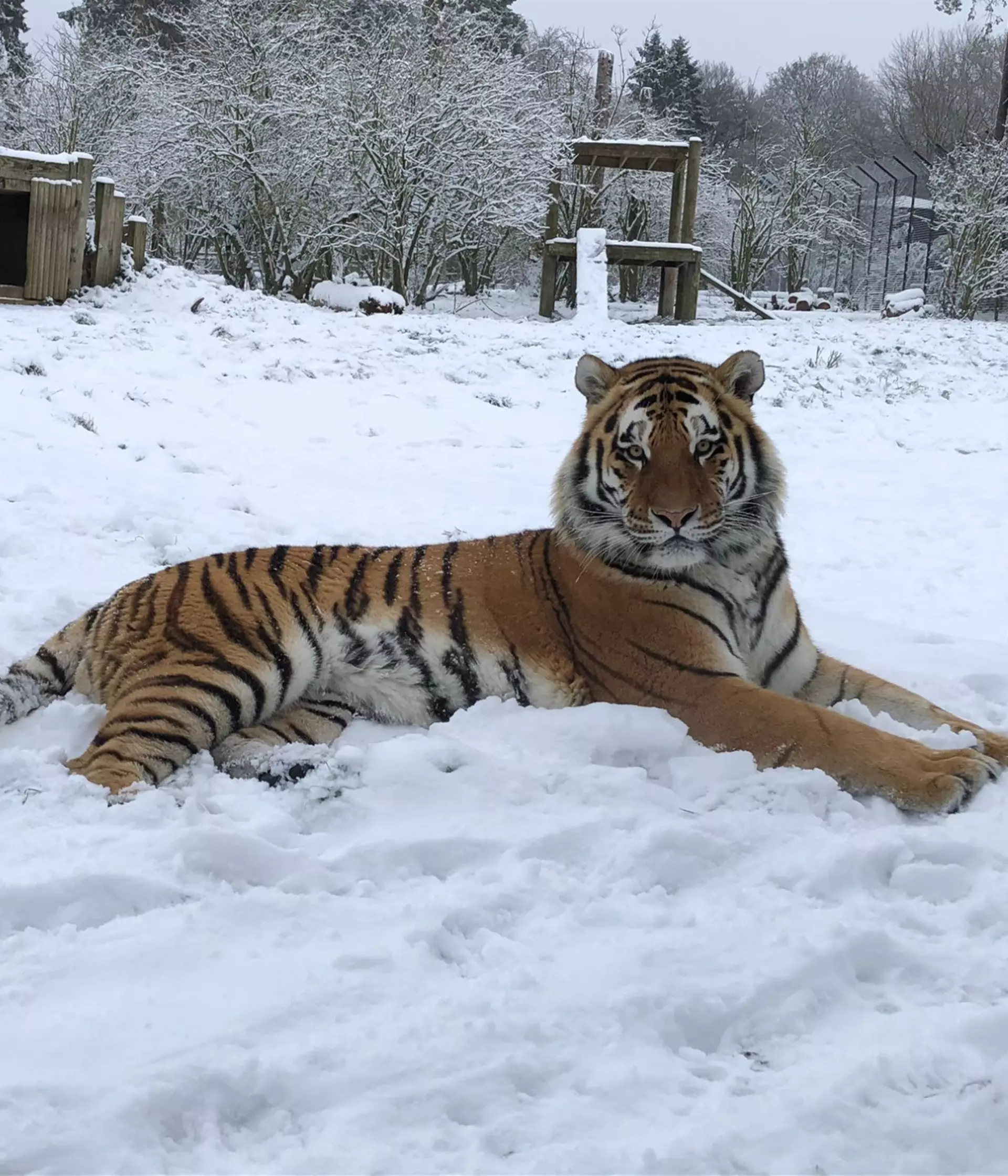
Animals to look out for at Whipsnade Zoo this winter
The festive season is nearly upon us, and there’s nothing quite like exploring Whipsnade Zoo’s winter wonderland on a frosty day out with the family. We’ve got a magical Santa's grotto and seasonal cheer for adults and children of all ages. And, of course, thousands of incredible animals for you to visit. Here's our checklist for what to look out for this winter.
Red pandas

Endangered in the wild, red pandas have thick, fiery red fur to protect them from their rainy, mountainous habitat in the Himalayas. Ever wondered why they have such a long and bushy tail? It acts as a cuddly blanket when they’re curled up in trees, and that's the first place you should look when trying to spot our red pandas this winter.
Red pandas are crepuscular - meaning they are most active at dawn and dusk - so you'll often stand the best chance of seeing them active either in the morning when you first arrive at the Zoo, or just before you leave at the end of the day.
In particular, look out for the newest addition to the family, inquisitive red panda cub, Hattie. She was born in June 2025 and is a vital boost to the conservation breeding programme for her endangered species.
Amur tiger

Another sadly endangered animal is the Amur tiger – the world’s largest tiger. These big cats live in cold climates where temperatures can dive to as low as -20 degrees! So our tiger, Miron, doesn't mind Whipsnade's winters at all!
Amur tigers have lots of really clever adaptations to the cold, including thick fur, a paler coat for blending into snowy surroundings, and big paws for padding across the snow.
They're majestic predators with powerful hunting abilities, and it's well worth stopping by our tiger habitat to pay Miron a visit. Head up to the top of the hill for the best views of his territory.
Wolverine
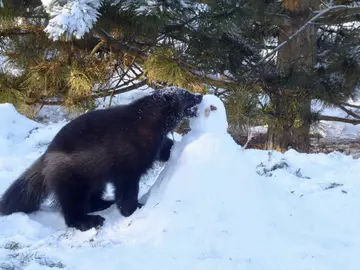
Wolverines are also impressive predators, and perfectly adapted to cold conditions. Found in remote snowy regions, they can smell prey up to six metres under snow – that’s more than the height of a double-decker bus!
We can't promise snow this winter, but we would recommend heading over to see what our wolverines are up to regardless - they're often scampering around their paddock and are really fascinating to watch.
And see if you can make out some of their adaptations to the cold. Their fur is thick and oily so is resistant to frost, they have large paws, plus a special upper molar that helps them rip meat from frozen prey.
Reindeer

Speaking of prey… reindeer have some really clever ways of coping with the cold. For example, in the summer, they spend up to 20 hours a day eating, and pretty much double their body weight. They can then live almost entirely off those fat stores during the winter, eating only the odd bit of lichen or moss – and carrots on Christmas Eve of course.
At Whipsnade we're home to a forest reindeer, Solen. And it really wouldn't be Christmas without saying hello when you visit. You'll find him next to our Lookout Lodges - where you can sleepover at the Zoo!
Penguins
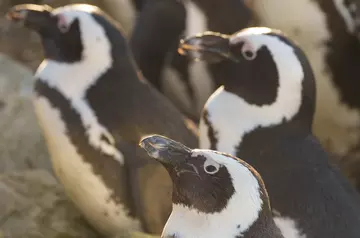
Just a short waddle away from the reindeer are our penguins. Guaranteed to feature in a snowy scene, penguins are often thought of as the ultimate festive animal, so definitely one to look out for on your winter visit. But not all penguins are from cold climates - actually, you’ll find African penguins at Whipsnade Zoo. And they have the best view at the Zoo over the beautiful Downs, which really is a picture postcard – or Christmas card - on a winter’s day.
We're also home to endangered rockhopper penguins. Known for their spiky yellow crests, they always enjoy investigating a themed treat on their pebbled beach, and Christmas is no different.
Camels

Another Christmas card favourite is camels. Whipsnade Zoo is actually home to domestic Bactrian camels with two humps, rather than the dromedary (one-humped) camels depicted in the nativity story. But even so, we'd recommend trying to see them - they're looking particularly fluffy at this time of year!
Whipsnade Zoo’s domestic Bactrian camels are an ambassador species for their critically endangered ‘cousins’, the wild camel (Camelus ferus), in Mongolia and China. Here, they need to be able to tolerate both really cold and really hot conditions and can withstand temperatures ranging from 40°C to -30°C! There are lots of features helping camels to cope with living in the desert, from their shaggy coat to their eyelashes. And they’re the only mammal to have oval shaped red blood cells instead of circular, which helps to stop them from dehydrating.
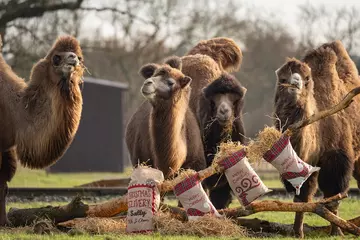
You can spot our camels from the Passage through Asia drive through area of the Zoo. Or, if you don't have the car, look out for them close to our greater one-horned rhinos.
The herd includes a calf born in May 2025 and his half-sister Sally, born in April last year. For her first Christmas, Sally was treated to her very own personalised hessian sack to search through for snacks alongside her family.
White rhinos
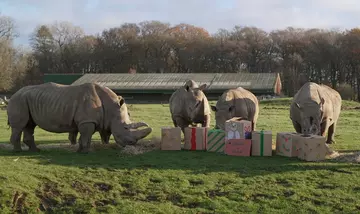
Sally wasn't the only one celebrating her first Christmas at the Zoo last year. Southern white rhino Kulu and his half-brother Benja had some festive fun, as zookeepers decorated their paddock with presents filled with their favourite snacks, encouraging them to put their great sense of smell to the test.
Our white rhinos are hard to miss. Not only are they huge (even the little ones are still big!), but they often like to hang out near the edges of their ginormous paddock, giving you the perfect viewing areas and photo opportunities.
See if you can notice some of their distinguishing features from our greater one-horned rhinos, and pay them a visit too, you'll find them next to our Asian elephants.
Elephants
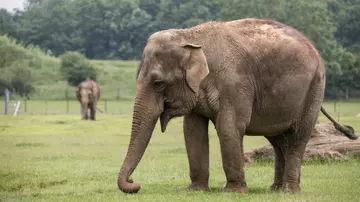
So then, of course, you must add elephants onto your checklist. Seeing elephants really is a powerful and humbling experience; you can't help but marvel at their sheer size and majestic nature. Visitors often say they could just watch them for hours, particularly our youngest Nang Phaya, as she can be quite a character!
Over the winter months, you're more likely to find the herd in their back sand paddock or inside of the Centre for Elephant Care where you can watch them from a balconied viewing platform.
Want to make your festive visit even more magical? You can book the ultimate experience to meet the elephants! In this once-in-a-lifetime opportunity, go behind-the-scenes of our amazing elephant house where you will get the chance to feed an elephant and find out all about our herd from an expert keeper. Guaranteed to be something you'll never forget. Limited spaces remaining so book today - and remember that Gold members get 10% off of our experiences.
Giraffes

And finally, no Zoo visit is complete without stopping to visit our giraffes - and they can be difficult to miss! With both indoor and outdoor viewing areas, you'll marvel at their towering presence and graceful movements. At Whipsnade, we're home to a family of endangered reticulated giraffes.
Last year, we were lucky enough to welcome two calves, really important additions to the conservation breeding programme for the endangered animals. They celebrated their first Christmas 2024 with breakfast inside their own giant Christmas stockings, so let's see what Santa brings them this year.
